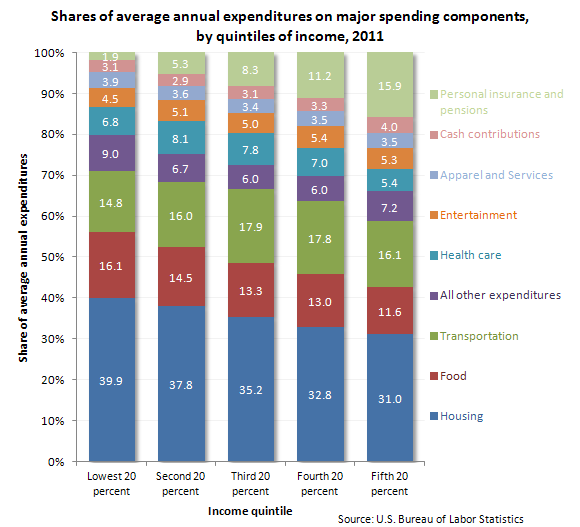September 27, 2012 (The Editor’s Desk is updated each business day.)
Consumer expenditures rise in 2011
Average annual expenditures per consumer unit rose 3.3 percent in 2011, the first yearly increase in spending since the 1.7-percent rise from 2007 to 2008. The rise in spending in 2011 barely outpaced the 3.2-percent increase in prices for goods and services from 2010 to 2011, as measured by the average annual change in the Consumer Price Index (CPI-U).
Click legend items to change data display.
[Chart data]
All major components of household spending increased in 2011. The 8.0-percent rise in transportation spending was the largest percentage increase among all major components. Overall spending on food and cash contributions (including payments for support of college students, alimony and child support, and giving to charities and religious organizations) both increased by 5.4 percent. Other spending highlights include a 4.9-percent rise in health care spending, and modest increases in housing (+1.5 percent), apparel and services (+2.4 percent), entertainment (+2.7 percent), and personal insurance and pensions (+0.9 percent).
Consumers in the lowest income quintile allocated more money to food and housing than the other quintile groups. The highest income group allocated more money to cash contributions, and personal
insurance and pensions (including payments for life insurance, other nonhealth insurance, pensions, and
Social Security) than any other group.

[Chart data]
Among consumers in all quintile groups, no clear trend existed for the shares allocated to transportation, health care, entertainment, and apparel and services in 2011.
These data come from the Consumer Expenditure Survey. To learn more, see "Consumer Expenditures — 2011" (HTML) (PDF), news release USDL-12-1937. Consumer units include families, single persons living alone or sharing a household with others but who are financially independent, or two or more persons living together who share expenses.
Related TED articles
Consumer expenditures
For citation purposes, this TED article is archived at
www.bls.gov/opub/ted/2012/ted_20120927.htm
Of interest
Spotlight on Statistics: National Hispanic Heritage Month
In this Spotlight, we take a look at the Hispanic labor force—including labor force participation, employment and unemployment, educational attainment, geographic location, country of birth, earnings, consumer expenditures, time use, workplace injuries, and employment projections.
Read more »
